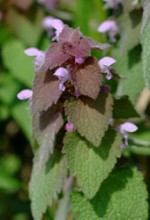 Dead nettle is a winter annual that is native to Europe and Asia. It is a member of the mint family (Lamiaceae ) that includes herbs such as basil, lavender, and rosemary as well as ornamentals such as coleus, bee balm, and lamb’s ear. The plant is frequently seen throughout the US in waste areas, gardens and lawns during the fall and spring growing in sun to part shade in moist, fertile soil. The common name, dead nettle, refers to the resemblance of the leaves of members of the nettle family that have stinging hairs. Since Lamium species do not have stinging hairs they are considered “dead”.
Dead nettle is a winter annual that is native to Europe and Asia. It is a member of the mint family (Lamiaceae ) that includes herbs such as basil, lavender, and rosemary as well as ornamentals such as coleus, bee balm, and lamb’s ear. The plant is frequently seen throughout the US in waste areas, gardens and lawns during the fall and spring growing in sun to part shade in moist, fertile soil. The common name, dead nettle, refers to the resemblance of the leaves of members of the nettle family that have stinging hairs. Since Lamium species do not have stinging hairs they are considered “dead”.
Description:
Square unbranched stems grow eight to twenty inches tall and carry opposite leaves that are triangular and pointed. The leaves are covered with fine hairs, have wavy to serrated margins, and shade from green at the base to purplish green at the tip. They are .8 to 2 inches long, have a crinkled surface, and are carried on .4 to .8 inches long leaf stalks (petioles) that distinguish them from another common weed, henbit dead-nettle (Lamium amplexicaule), that has stalkless leaves. Red purple flowers are ½ inch long and appear with leaves in terminal clusters in spring for about 1 ½ months. Each flower has upper and lower lips of fused petals. The top lip is hood-like while the lower lip is divided into two lobes. The flowers are an important source of nectar and pollen for bees. Plants readily self seed and can form dense colonies. The root system is fibrous.
Control:
Since plants are annuals and spread by seeds eliminating plants before flowering is the best way to eliminate them. They can easily be pulled up by hand. Maintaining a dense turf will significantly hinder the establishment of the plants in a lawn. In severe cases broadleaf weed killers with 2,4 D, MCPP (mecoprop), Dicamba, or Triclopyr, can be used.